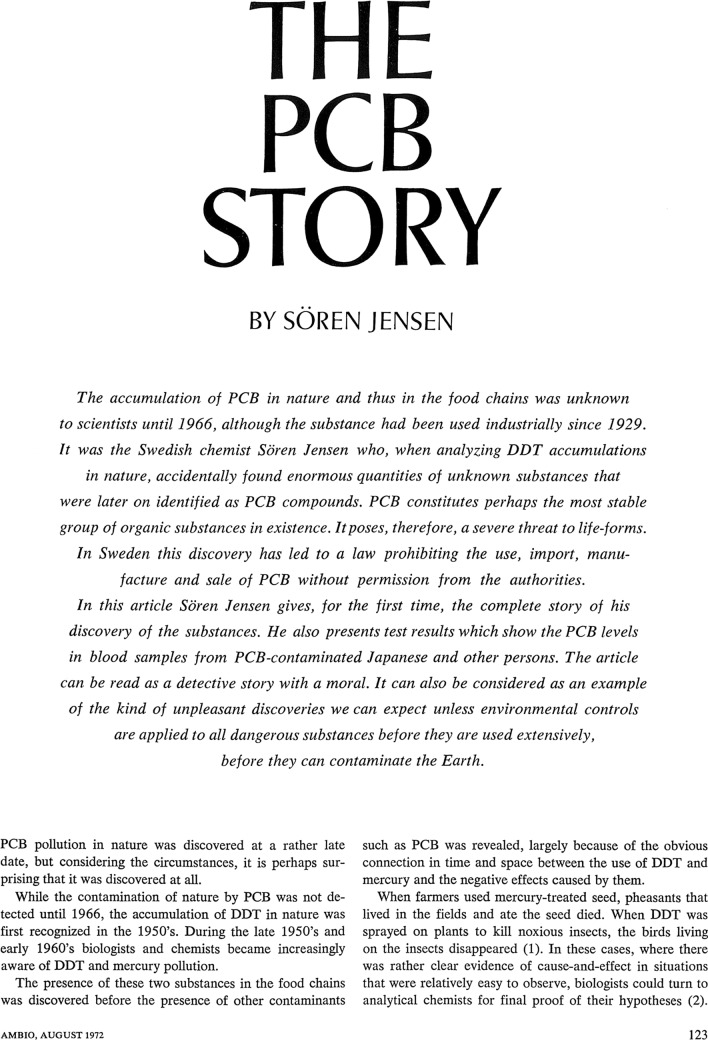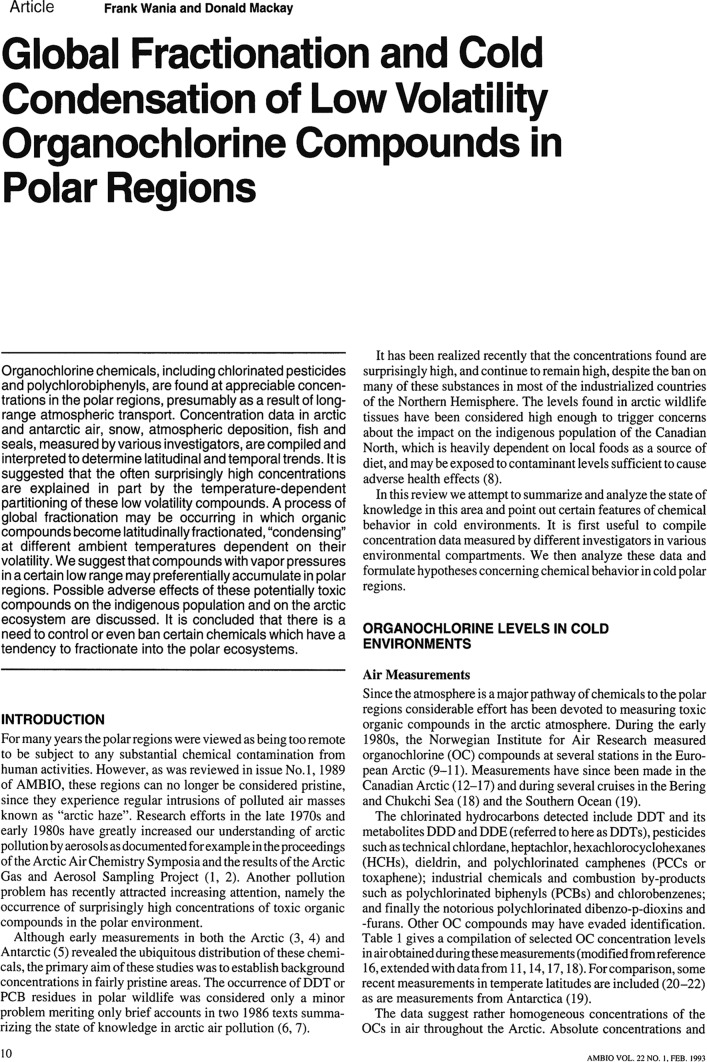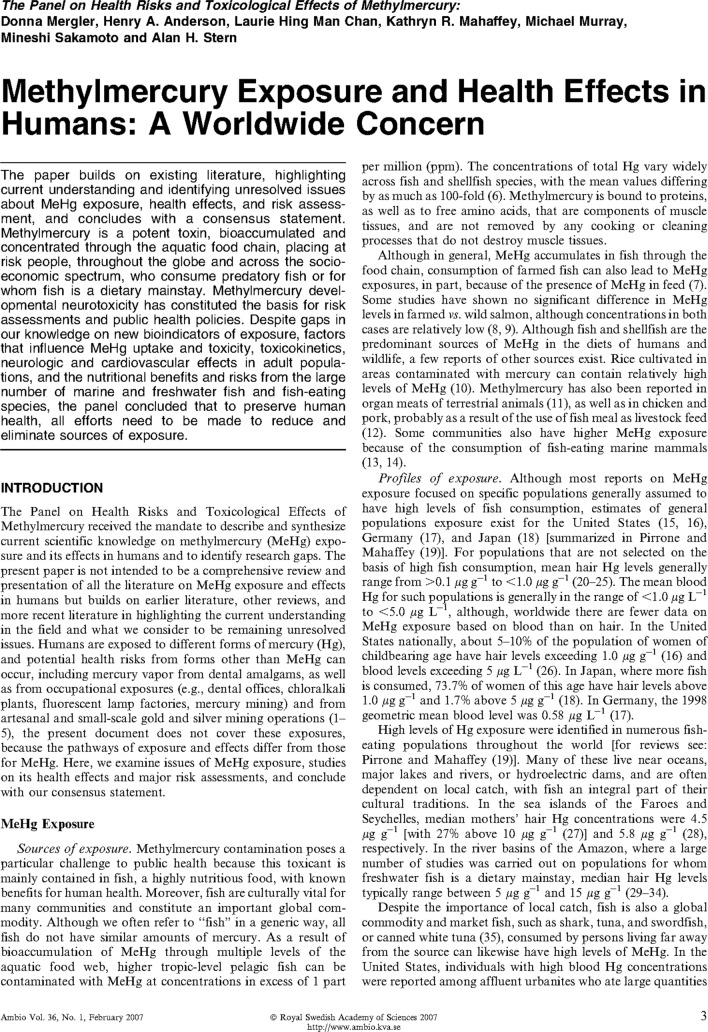In the field of environmental contaminants three Ambio articles are highlighted as important corner stones in building the understanding of the field that we have today. The first is Sören Jensen’s article about the discovery of PCBs (1972), the second is a state of the art summary of the transport of organochlorine compounds to the Arctic by Wania and Mackay (1993), and the third is the article by Mergler et al. (2007) who give a comprehensive update on the knowledge at the time about methylmercury exposure and health effects in humans. In separate articles in this issue, Wania (2021) and Mergler (2021) have given their hindsight perspectives of their articles. In Jensen’s case (2021) his views are presented in the form of an interview, where I asked the questions and he provided the answers, as his vision problems make writing difficult.
The importance of these contributions become obvious when one considers the knowledge we had and the questions we asked at the time. In 1972 it was ten years since Rachel Carson published “Silent Spring”, a book that had enormous influence over the way we viewed agricultural biocides in general and chlorinated insecticides in particular (Carson 1962). Arguably, Rachel Carson did not only write a bestselling popular science book, she also did what researchers should have done: combine results and information from different branches of biology and chemistry. Science, obviously, was at the time too compartmentalized to do it, so it took a journalist and science writer to see the big picture. The main conclusions today appear simple and obvious: When you spread out biocides that do not degrade rapidly, other organisms in addition to those you target may be adversely affected and even more so as many of these substances tend to bioaccumulate, i.e. increase in concentration the higher up in the food chain they get. Rachel Carson wrote mostly about chlorinated insecticides like DDT, aldrin, dieldrin and their effects on birds. DDT was already a familiar substance and although she in “Silent Spring” pointed out that several other chlorinated insecticides were both more toxic and persistent, the subsequent debate mostly circled around just DDT. Given the prominence in the debate, it is no surprise that DDT was intensively studied. Two major metabolites were identified: DDE and DDD, both more persistent than their parent chemical. Environmental samples from all over the globe were analyzed, mostly with gas-liquid chromatography, and especially DDE peaks were found both in samples from practically everywhere including polar regions and those from deep oceans. It seemed hard to believe that a compound mostly used in tropical and temperate regions would get that far in measurable quantities in a relatively short time.
Two of three papers selected for this celebration of important Ambio articles in the field of environmental contaminants relate to this problem area. Sören Jensen identified PCBs as environmental contaminants (Jensen 1972). For some time by then, mysterious peaks in the electron capture gas chromatograms had been noted. They were often classified as impurities in the solvents or carrier gas and seen as a hindrance in the analysis of agricultural pesticides. One of them overlapped with DDE, which meant that it either got undetected or overestimated dependent on how the chemist dealt with the interpretation problem. Some of the reports of high concentrations of DDE, often presented as “total DDT” at an early state after introduction of the insecticide and in odd places were in fact one of the PCBs, that had been around much longer and in totally different usages.
Even when PCBs had been identified and could be separated the distribution pattern of DDT, and its more persistent metabolite DDE, had a poor match with the places of application. The presence in coastal marine organisms was first explained as caused by runoff from agricultural areas and river input to the sea, but Ed Goldberg among others pointed out that the high concentrations in the marine environment off southern California could not be explained that way, and he suggested an evaporation and atmospheric fall-out process which he called “global distillation” (Goldberg 1975). Robert Riseborough—in finding that the evaporation/fall-out process with DDE in terrestrial environments could happen over and over again – talked about “grasshopper jumps”. It was also likened to “ping-pong balls bouncing on a hard surface with some soft patches were many balls would come to rest” seeing cold and acid areas as the soft patches. Rappe (1974) described the Arctic in relation to moderately volatile chlorinated hydrocarbons as following “the rule of the cold wall”. Gradually a deeper understanding of the phenomena developed and in the Ambio article Global fractionation and cold condensation of low volatility organochlorine compounds Wania and Mackay (1993) gave the state of the art.
The story of mercury as an environmental contaminant can be said to have started in the 1950s. In Japan the Minamata disease struck, first thought to have been a nerve infection but later identified as methylmercury poisoning. In Sweden, dead birds of prey and seed-eaters like pheasants (Phasianus colchicus) and yellowhammers (Emberiza citrinella) were found to contain high levels of mercury and Karl Borg identified the seed-dressing agent methylmercury as the cause (Borg 1966). That put the initial focus on environmental mercury research on the methylated form. From earlier toxicological studies mostly in the occupational health field it was also known that alkyl mercury compounds and methylmercury in particular were the most toxic to humans as they pass both the blood-brain barrier and the placenta barrier. The human body would degrade all tested organomercurials but at different rates and methylmercury was the one with the longest half-life and also therefore seen as the most harmful. When methylmercury had finally and conclusively been identified as the cause of Minamata disease (Hachiya 2006), transferred to humans by fish and shellfish, the question came up if methylmercury used in agriculture could find its way to water courses and fish and back to humans. Neutron activation analysis of total mercury quickly revealed relatively high concentrations in fish in Sweden, especially in predatory ones like pike (Esox lucius). The more global interest in environmental mercury rose when a Norwegian student in Canada, Norvald Fimreite, found high levels of mercury in fish in the Great Lakes (Fimreite 1970).
To understand how things unfolded it helps to look at the analytical possibilities at the time. Total mercury was mostly analyzed with a colorimetric method that used dithizone. It was not very sensitive and would mistake e.g. copper and cadmium for mercury. The far better alternative was neutron activation, if you had a nuclear reactor at hand. In Stockholm we had one, now almost forgotten, in the rock below the Royal Institute of Technology. Torbjörn Westermark adopted it for mercury analysis. In the 1950s the methods for methylmercury analysis were insensitive, but with [the development of the] electron capture detector and Gage extraction, methylmercury chloride could be measured in low concentrations. Thus, in the mid-1960s we had a good, but hard to get by and expensive, method to analyze total mercury and a good inexpensive one to analyze methylmercury.
The further studies of Alf Johnels, Torbjörn Westermark and colleagues (Johnels et al. 1967) showed that concentrations of mercury in their standardized one kilogram pike, contrary to expectations, were lower in water courses in agricultural areas than in many forested ones. The mystery thickened when Gunnel Westöö found that practically all mercury in fish, regardless of from where it came, was in the form of methylmercury (Westöö and Norén 1967). The explanation came when Sören Jensen and Arne Jernelöv discovered that microorganisms present in lake sediment could convert inorganic mercury to mono- and di-methyl mercury (Jensen and Jernelöv 1967, 1969). Many toxicologists initially doubted the findings, arguing that organisms would not invest energy to produce highly toxic compounds with no benefit to the producer. The experiments, however, could easily be reproduced and the results were confirmed over and over again and thus gradually accepted.
Later two biochemical mechanisms for the conversion were identified. John Wood and coworkers found the B12 itself and bacteria that produce it can methylate mercury (Wood et al. 1968). Lars Landner showed that an erroneous synthesis of methionine in the presence of mercury, may occur in all methionine producing organisms, resulting in methylation of mercury instead of sulfur in homocysteine (Landner 1971). Thus, methylation of mercury does not take place in man and other mammalians and birds, for whom methionine is an essential amino acid, and for whom methylmercury’s ability to pass the blood/brain and placenta barriers lead to especially high intoxication risks. A high capacity for (di)methylmercury formation in sulfate reducing marine bacteria was also found and a third biochemical pathway postulated.
As the toxicological focus was on methylmercury and as a reliable analytical method was more readily available for it than for total mercury, a large number of methylmercury analysis were performed and the environmental mercury discussion centered around this compound. Then came flameless atomic absorption spectroscopy, a highly specific and sensitive method for total mercury analysis, and a growing interest in global circulation of mercury and the main focus shifted. A number of toxicological questions with regard to methylmercury that were identified already during the Minamata disaster remained and more were added during the Iraq mercury catastrophe, when imported green revolution wheat was imported from Mexico and methylmercury dressed to protect it from fungal attacks and then not only planted but also eaten by humans and domestic animals.
Studies of populations at the Seychelles (Myers et al. 2003) and Faroe islands (Grandjean et al 1997) gave conflicting results as to the toxicological effects of relative low level exposure from eating methylmercury containing marine organisms. The Ambio article “Methylmercury Exposure and Health Effects in Humans” by Mergler et al. (2007) summarizes the knowledge.
Naturally, we have learned a lot when it comes to the risk that environmental contaminants pose, the administrative requirements are much stricter and the available test systems far more advanced than they were, especially for agricultural chemicals. Despite this, as Martin (2021) points out, there are still many holes and we have not succeeded in eliminating the threats from persistent organic substances despite our discoveries and improved scientific knowledge. Also Farrington (2021) stresses that our societies keep adding new chemicals to the ever longer list of environmental contaminants. It might be that the greater risks for the future may not be caused by individual chemicals in high concentrations but come from the collective synergetic effects of a huge number of substances, each of them in concentrations well below toxic threshold values. Such effects will be very difficult to identify the cause of, when we detect them in nature, and almost impossible to find in pre-use screening. Even when such causes are identified, legislating to prevent them will be a nightmare. Farrington (2021) also underlines that we, including environmental scientists, for far too long have neglected the accumulation of plastics in the environment. They don’t bioaccumulate the way traditional POPs do, but pose a grave long-term threat anyway.
Footnotes
Publisher's Note
Springer Nature remains neutral with regard to jurisdictional claims in published maps and institutional affiliations.
References
- Borg K. Mercury poisoning in Swedish wildlife. Journal of Applied Ecology. 1966;3:171–172. doi: 10.2307/2401456. [DOI] [Google Scholar]
- Carson R. Silent Spring. USA: Houghton Mifflin; 1962. [Google Scholar]
- Farrington, J. 2021. Reflecting on three influential Ambio articles impacting environmental biogeochemistry research and knowledge. 50th Anniversary Collection: Environmental contaminants. Ambio, Vol. 50. 10.1007/s13280-020-01416-7. [DOI] [PMC free article] [PubMed]
- Fimreite, N. 1970. Mercury contamination of Canadian fish and fish-eating birds’ Background papers for the Great Lakes environmental conference. Toronto: Ontario.
- Goldberg E. Synthetic organohalides in the sea. Proceedings of the Royal Society London B. 1975;189:277–289. doi: 10.1098/rspb.1975.0057. [DOI] [PubMed] [Google Scholar]
- Grandjean P, Weihe P, White RF, Debes F, Araki S, Yokoyama K, Murata K, Sorensen N, et al. Cognitive deficit in 7-year-old children with prenatal exposure to methylmercury. Neurotoxicology and Teratology. 1997;19:417–428. doi: 10.1016/S0892-0362(97)00097-4. [DOI] [PubMed] [Google Scholar]
- Hachiya N. The history and the present of Minamata disease—Entering the second half a century. Japan Medical Association Journal. 2006;49:112–118. [Google Scholar]
- Jensen S. The PCB story. Ambio. 1972;1:123–131. [Google Scholar]
- Jensen, S. 2021. Afterthoughts from an environmental pollution discovery: Interview with Sören Jensen. 50th Anniversary Collection: Environmental contaminants. Ambio, Vol. 50. 10.1007/s13280-020-01453-2. [DOI] [PMC free article] [PubMed]
- Jensen S, Jernelöv A. Biological formation of methyl mercury in sediments. Nordforsk. 1967;14:3–6. [Google Scholar]
- Jensen S, Jernelöv A. Biological methylation of mercury in biological organisms. Nature. 1969;223:753–754. doi: 10.1038/223753a0. [DOI] [PubMed] [Google Scholar]
- Johnels AG, Westermark T, Berg W, Persson PI, Sjöstrand B. Pike (Esox lucius L.) and some other aquatic organisms in Sweden as indicators of mercury contamination in the environment. Oikos. 1967;18:323–333. doi: 10.2307/3565108. [DOI] [Google Scholar]
- Landner L. Biochemical model for the biological methylation of mercury suggested from methylation studies in vivo with Neurospora crassa. Nature. 1971;230:452–454. doi: 10.1038/230452a0. [DOI] [PubMed] [Google Scholar]
- Martin, J.W. 2021. Revisiting old lessons from classic literature on persistent global pollutants. 50th Anniversary Collection: Environmental contaminants. Ambio, Vol. 50. 10.1007/s13280-020-01413-w. [DOI] [PMC free article] [PubMed]
- Mergler, D. 2021. Ecosystem approaches to mercury and human health: A way toward the future. 50th Anniversary Collection: Environmental contaminants. Ambio, Vol. 50. 10.1007/s13280-020-01455-0. [DOI] [PMC free article] [PubMed]
- Mergler D, Anderson H, Chan LHM, Mahaffey K, Murray M, Sakamoto M, Stern A. Methylmercury exposure and health effects in humans: A worldwide concern. Ambio. 2007;36:3–11. doi: 10.1579/0044-7447(2007)36[3:MEAHEI]2.0.CO;2. [DOI] [PubMed] [Google Scholar]
- Myers GJ, Davidson PW, Cox C, Shamlaye CF, Palumbo D, Cernichiari E, Sloane-Reeves J, Wilding GE, et al. Prenatal methylmercury exposure from ocean fish consumption in the Seychelles child development study”. The Lancet. 2003;361:1686–1692. doi: 10.1016/S0140-6736(03)13371-5. [DOI] [PubMed] [Google Scholar]
- Rappe, C. 1974. Chemical behavior of Pesticides. In Ecological Problems of the circumpolar area, 29-32 + 37. Norrbottens Museum, Luleå, Sweden.
- Wania, F. 2021. The unlikely fate of a term paper. 50th Anniversary Collection: Environmental contaminants. Ambio, Vol. 50. 10.1007/s13280-020-01456-z. [DOI] [PMC free article] [PubMed]
- Wania F, Mackay D. Global fractionation and cold condensation of low volatility organochlorine compounds in polar regions. Ambio. 1993;22:10–18. [Google Scholar]
- Westöö, G., and K. Norén. 1967. Kvicksilver och metylkvicksilver i fisk. Vår Föda 10.
- Wood JM, Kennedy FS, Rosén CG. Synthesis of methyl mercury compounds by extracts of a methanogenic bacterium. Nature. 1968;220:173–174. doi: 10.1038/220173a0. [DOI] [PubMed] [Google Scholar]





